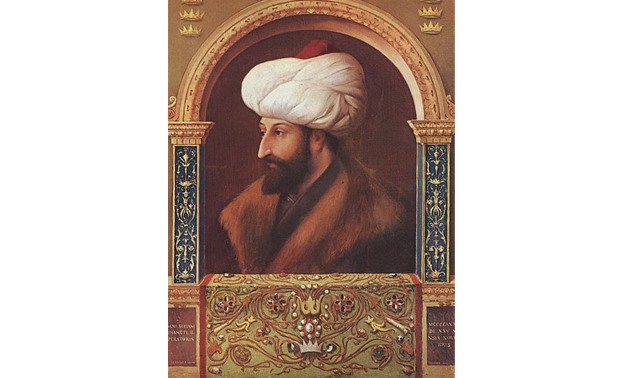Which Best Explains the Legal Reforms of the Ottoman Emperor
The basic element in Mahmuds reforms was the reconstruction of the army to make it a fit instrument for preserving the Ottoman Empire against both the encroachments of European powers and the separatist ambitions of local potentates. Which best explains the spread of culture along East Africas Swahili coast.

Ottoman Empire The Peak Of Ottoman Power 1481 1566 Britannica
Ottoman economic reforms Ottoman Empire Ottoman workers were increasingly paid in cash rather than in goods financial enterprises like banking increased.

. During the Crimean War Russia. The city became an Islamic capital. Religious freedom was allowed with a tax for non-Muslims.
Britain now proposed to supervise governmental reforms in the Asian provinces although that was skillfully. Which is not a reason for the conflict between the Ottoman Empire and the Safavid Empire. And in only 6 years the Young Turks did extremely well.
678 massive chineese rebellion that devasted much of the country between 1850 and 1864. Terms in this set 25 Restructuring reforms by the nineteenth-century Ottoman rulers intended to move civil law away from the control of religious elites and make the military and the bureaucracy more efficient. The process of modernization involved adopting models and.
Under the Tanzimat effort to centralize administration all legal authority became concentrated in the hands of the sultan. Which of the following is not among the earliest reforms of the Ottoman Empire. Suleimans reforms gave the Ottoman Empire a recognizably modern administration and legal system more than 450 years ago.
Ottomian reforms for women Ottoman Empire The right of women to distribute their property or cash through trusts to family members was ended. Which best describes a result of Emperor Süleymans reforms of Ottoman law. A Enver Pasha question.
November 3 1839 and the Hatt-ı Hümayun Imperial Edict. The Ottoman territories in Europe were reduced to Macedonia Albania and Thrace and European influence had attained new dimensions. Suleiman Greatest Sultan of the Ottoman Empire ad Din known to Europeans as Barbarossa.
Both of whom had a mutual rivalry with Spain. The best-known of those reforms are the Hatt-ı Şerif of Gülhane Noble Edict of the Rose Chamber. They were an attempt at modernization to stop the decline of Ottoman power.
The Tanzimat reform movement came to a halt by the mid-1870s during the last years of Abdülazizs reign. African culture mingled with traditions carried by Arab traders. He instituted protections for Christian and Jewish citizens of the Ottoman Empire denouncing blood libels against the Jews in 1553 and freeing Christian farm laborers from serfdom.
Which was a result of the Ottoman conquest of Constantinople in 1453. Eastern Rumelia was soon lost when it united with Bulgaria in 1885. Sultan Abdülmecid implemented the Tanzimat reforms.
Which best explains the increase in the African slave trade after the fifteenth century. Religious freedom was allowed with a tax for non-Muslims. Which is not an explanation for the conflict between Ottomans and the Safavids.
The Tanzimat reforms 183976 The Tanzimat is the name given to the series of Ottoman reforms promulgated during the reigns of Mahmuds sons Abdülmecid I ruled 183961 and Abdülaziz 186176. Which best describes a result of the legal reforms of Süleyman the Ottoman emperor. The Tanzimat reforms were carried out between 1830 and 1870 in the Ottoman Empire.
Womens rights in general were restricted. Barbarossa rebuilt the Ottoman fleet until it was bigger than the other Mediterranean fleets. The settlement was a major defeat for the Ottomans.
This fact notwithstanding the. Which best describes a result of Emperor Süleymans reforms of Ottoman law. They were a wide-ranging series of educational political and economic reforms.
As a result little could be done when Abdülaziz began abusing his power and adopted revisionary policies. Enver Pasha and the Young TurksCUP had the best intentions for the modernization of the empire. Atatürk İnkılâpları were a series of political legal religious cultural social and economic policy changes designed to convert the new Republic of Turkey into a secular modern nation-state implemented under the leadership of Mustafa Kemal Atatürk in accordance with the Kemalist ideologyHis political party the Republican Peoples Party CHP.
What modernization did the Young Turks do exactly. Implementation of laws to protect women and children from abuse and abandonment. Which best explains the legal reforms of the ottoman emperor soleyman reforms created unlimited religious freedom reforms allowed religious freedom with a tax on non-muslims reforms imposed islam on all subjects reforms allowed religious freedom for.
In 1535 Spain won an important victory against the Ottomans which led Suleiman to make an alliance with France. Was the worlds bloodiest civil war. Most of the ottoman empire reforms came about because of the worry that European powers may interfere with their affairs they started making changes when their feudal system began to crumble and so they were able to legitimize his rule by re establishing the emperor and unifying the old and new japan to be as one and through this the empire was able to restore its self until.

Rights Of The Non Muslim In The Ottoman Empire Egypttoday


Comments
Post a Comment